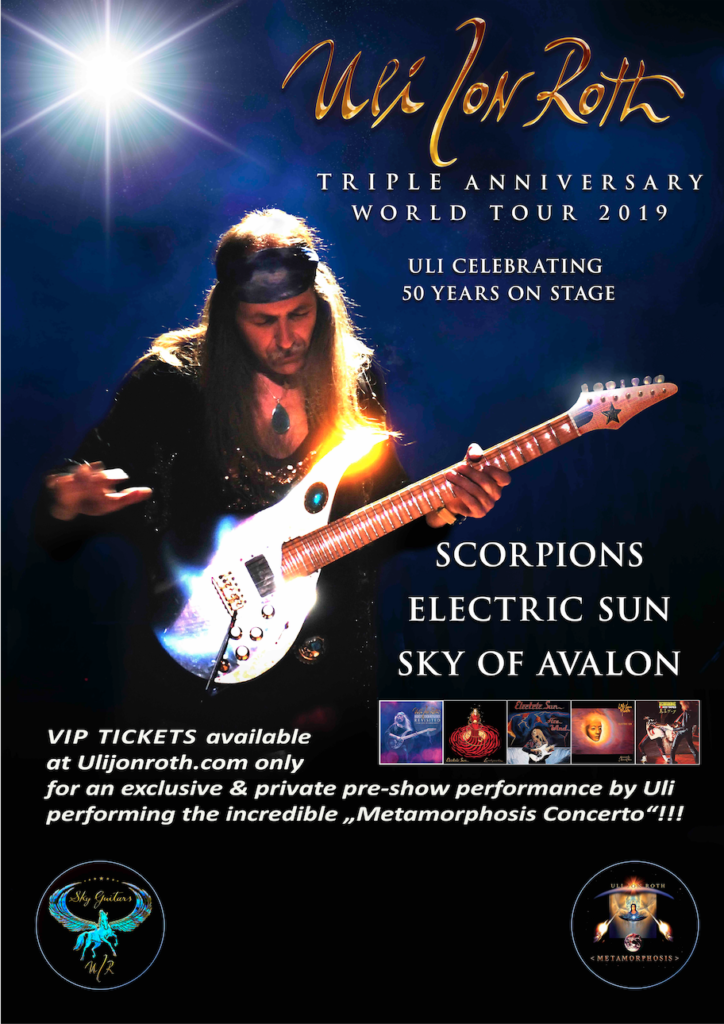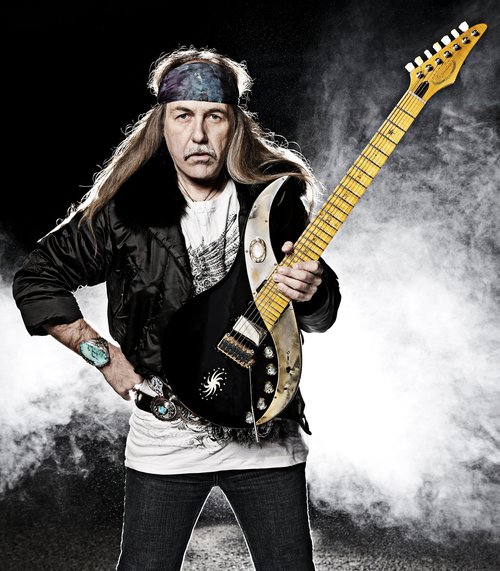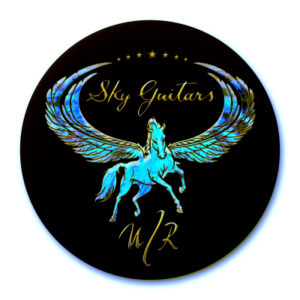
Showing little signs of slowing down as a composer, recording artist or live performer, legendary German guitar maestro UIi Jon Roth Is in the midst of an extensive 50th Anniversary North American tour that started at the venerable Whisky A-Go-Go in Hollywood March 20, and will see him and his band traverse the continent, including playing nine shows in Canada. It is a continuation of a tour that began last year in Japan and Europe, marking the beginning of his sixth decade as a professional musician.
Perhaps best known as the lead guitarist for The Scorpions from 1973 through 1978 (replacing Michael Schenker), he went on to forge a career as one of the most innovative and influential rock guitarists of his generation, being the first to seamlessly blend elements of classical music into the hard rock genre, through his various solo projects, collaborations and his 1980s band Electric Sun. He also designed his own guitars, which were custom made and incorporated additional frets. These ‘Sky’ guitars have become his trademark, with well-known manufactured Dean producing 25 special edition instruments based on Roth’s guitar, in 2011. In 2018, he opened his own guitar company, UJR Sky – Guitars.
His most recent studio album was 2015’s Scorpions Revisited, while he also released the live DVD/CD Tokyo Tapes Revisited – Live in Japan in 2016.
More focused on the future than on the past, Roth is nonetheless proud of his extensive, eclectic and exciting back catalogue of recordings, and his consistent excellence as a live performer. Yet, he said hitting the 50 year mark as a professional musician is not something he has spent a great deal of time pondering.
“I have never really thought about how it feels. When I first started, which was 1968, I didn’t think anything about how long my career would be or anything like that. I just wanted to do music. The 50 years was just a by-product of that, and it just happened, but that was never the motivation behind it. And perhaps that is the secret – that I never had a plan – other that to just keep making music, because it still feels fresh to me. It still feels good to be on tour. I am still enjoying it almost all of the time,” he said from his home in Wales, where he has lived for four decades.
“I think the most important thing is always progress. I am trying to get better all the time. I am still taking it very seriously, I am quite officious in that sense. I want to become a better player, a better performer so every show gives me a chance to improve on that. So, it’s still a learning curve. A lot of things you learn only on stage, you can’t learn them at home – you just can’t. And a lot of my most important advances have been made on stage where you come up with something new. You need to keep it fresh by approaching the songs in a way that they have to feel like they have just been written, and that’s very important for them to remain relevant for now.
“I don’t want to just go through the motions because there is no inspiration and it feels dead, and that’s the kiss of death. Inspiration is what makes it come alive, in yourself and also in the listener. It’s a two-way kind of thing, you know? Each show is different, and I am always leaving plenty of room for improvisation, meaning we are taking plenty of chances every night to do some things quite differently. And I have got a band which is able to handle that, so if I throw anything slightly strange at them, they will just pick up on it and will enter that new territory with me.”
Throughout the entirety of his career, from the Scorpions through Electric Sun, his innovative combining of classical and rock guitar on his Sky of Avalon, Metamorphosis of Vivaldi’s Four Seasons, and Transcendental Sky Guitar albums, one thing that has always been at the forefront is Roth’s focus on melody. All the technical wizardry, improvisational dynamism and progressive thinking is only window dressing if there is not a core melody on which to hang one’s hat, according to Roth.
“I am totally melody driven and anything that doesn’t have a melody I find it usually quite boring and it doesn’t speak to me. Melody is the soul of music. It is the highest and most spiritual aspect of the music. Rhythm is the motor, the engine while the harmony is like the bedrock and the ocean that the song swims in, and the scenery. But then the melody is the spirit of the person and what the song is all about. Al through my life I have always been most attracted to that element and I have always tried to become more melodically in tune with it,” Roth explained.
 “Sometimes that means you have to play less and less and less, until you really know just the most important notes are the right ones and don’t play a single note more. All these arpeggios and stuff, they’re all very nice as long as they are melodic arpeggios. It they are just arpeggios to display how quickly you can get from A to B on the fretboard, it’s the most boring and inane thing and it’s not very exciting, at least not for me. It turns me off.
“Sometimes that means you have to play less and less and less, until you really know just the most important notes are the right ones and don’t play a single note more. All these arpeggios and stuff, they’re all very nice as long as they are melodic arpeggios. It they are just arpeggios to display how quickly you can get from A to B on the fretboard, it’s the most boring and inane thing and it’s not very exciting, at least not for me. It turns me off.
“Some people have a tendency to play a melody and do so much in between and it takes away from the spirit of the thing – it minimalizes something that should be bigger. If you know which notes not to play and which are the important ones, then you are on to something. And the older I get, that is something I am still learning about, and I am aiming for that, to really make sure that every note that I play is saying something and it’s meaning something and it’s hitting the target.”
Growing up in Germany, Roth heard all of the great music coming out of the U.S. and U.K. in the mid-to-late- 1960s but became obsessed with the game-changing compositional and performing style of Jimi Hendrix.
“Hendrix was such a great genius. He did so many things that were completely novel at the time and beyond, and he was just all about inspiration. He was a great artist, one of the greatest artists ever. Jimi was doing things his own way. With him, every note counted. He was always exploring, and he always took huge chances and sometimes when he wasn’t feeling so well, because his life was hard doing all these tours with very little sleep, sometimes he wasn’t at his best and you could really feel that he was struggling and fighting for it. And then suddenly in the next moment he would be there again, and you will hear this moment of pure greatness,” he said.
“You could see the struggle for inspiration or for expression literally onstage taking place in front of you, which to me is the sign of a real artist, which was very exciting.”
His work, in turn, has been an inspiration to subsequent generations of guitar players across the rock, hard rock and metal genres, as Roth has been name-checked by the likes of Steve Vai, Joe Satriani, Jason Becker, Metallica’s Kirk Hammett, Marty Friedman and many more players from both Europe and North America. They and many music journalists over the years and lauded him for being the first to successfully bring elements of classical music into rock guitar.
“It makes you feel like you have done something right, done something of value. I was just following that star in my mind that was guiding me. I saw something in the distance that I wanted, and it was to hear classical music interpreted through the guitar, through this way of playing. And apparently I wasn’t the only one because then afterwards kids caught on to that and they liked it too, and they made it their own and pretty soon everybody was playing arpeggios,” he said, adding that he wasn’t doing it necessarily to create a new genre or commercialize it, as has been done in later generations though the rise of symphonic metal and shows such as those put on by the likes of the Trans-Siberian Orchestra.
“I don’t really know too much about symphonic metal because I don’t really follow that scene. When I started doing these things in the mid-1980s and wrote concertos and symphonic pieces and also performed some of them with classical orchestras, where I integrated stuff into those performances from my favourites from the classical repertoire like Mozart’s Requiem, I guess that was maybe a forerunner because then the Trans-Siberian Orchestra used some of those songs many years later, and then there were all these people doing the ‘rock meets classical] shows. But they did it in a much more commercial way than I did. They were aiming for the mass market and I wasn’t. I just wanted to do something that would musically excite me, and artistically excite me.”
For Roth himself, he simply didn’t see anyone else doing it, so decided to try it himself because he thought there was great application for some of the musical structures and stylings from the classics that could be brought into rock music.
“I have always been an explorer and I have become an explorer without even trying. I guess it’s just in me. I just like to try and boldly go where no one has gone before, you know. Sometimes I succeed and sometimes I don’t. It just came naturally because I was exploring the guitar as an instrument. At that time, as a young musician, I don’t want to say that rock guitar was in its infancy because there were already people like Eric Clapton, Hendrix and Jeff Beck doing great things in the pentatonic range, but the full technical aspects of particularly rock guitar had not been explored yet,” he said.
“At the time I was listening to a lot of violin concertos and I saw a huge discrepancy in the technical end in what the violin was doing in the days of say, Vivaldi, 300 years ago or whatever, and what was being done with the electric guitar. Rock guitar seemed to be limited in what it was doing. No one was playing these arpeggios and stuff, so I thought why not try? I want to hear that on the guitar. I wanted to do what I heard on the violin using an electric guitar, and at that time the field was wide open because it hadn’t really been done yet. I guess I came at the right time with the right kind of approach because most of my peers were not really into the classical thing and with me it was a no brainer. I just loved it and I wanted to translate it to the electric guitar, and that was that.”
 For the forthcoming tour, Roth said he is going to be performing some refurbished and re-energized versions of a number of songs from his post-Scorpions progressive rock band, Electric Sun. From 1979 through 1985, the band released three studio albums: Earthquake in 1979, Fire Wind in 1981 and Beyond the Astral Skies in 1985, garnering a huge fan base for the band in Japan in particular, but also within pockets of North America and Europe.
For the forthcoming tour, Roth said he is going to be performing some refurbished and re-energized versions of a number of songs from his post-Scorpions progressive rock band, Electric Sun. From 1979 through 1985, the band released three studio albums: Earthquake in 1979, Fire Wind in 1981 and Beyond the Astral Skies in 1985, garnering a huge fan base for the band in Japan in particular, but also within pockets of North America and Europe.
“We used to play maybe one or two Electric Sun pieces over the years, but I haven’t done so in a long time. We certainly never played a whole Electric Sun set like we are now, not since 1985, which was my last ever Electric Sun tour, which happened to be in America. And it’s quite exciting because it gives me a chance to really dive back into that stuff and to find new angles and rediscover old angles,” he said.
“The recent tours we have done in Japan and some parts of Europe playing that programme, it’s been a really good learning curve and the material is evolving, and it’s coming back to life quire strongly. For many years I was doing the Sky of Avalon [1996], Transcendental Sky Guitar [2000], where it was virtuoso guitar where we did the Vivaldi Four Seasons and stuff like that. And then I did all sort of other things.
“The Electric Sun material is so different because it needs a rock band, but you need an ace kind of rock band, who really knows what they’re doing. Very often over the years I would make guest appearances here and there and play with different backing musicians in Italy and Spain, and the Electric Sun material is very demanding to play, even when it doesn’t sound difficult, it is actually difficult to play. Each song has its own kind of threshold of difficulty that you need to be on top of in order to really bring it to life on stage effortlessly. It’s all not easy listening material; it’s all about being intense. It’s very intense and in that sense it’s exhausting.”
For the North American tour, Roth said the show lasts about three hours, with much of the first set being dedicated to Electric Sun, with the rest of his impressive catalogue, including a number of Scorpions tunes, comprising the second set, after a break.
“It was a challenge to put together a set list and I had to think for a long time and the process is not yet finished, so certain songs are still being bumped in or out. We are still fine tuning it, because it’s not only that I want to choose the best material that I had, but also within the course of the evening you have to make sure songs flow well into one another and don’t contradict one another, and a lot of my very best stuff is hyper intense: there are these epic 10-minute, 12-minute pieces and here is only so many of them you can play in a show. So that was actually hard to make those choices.
“And also, before we even start the proper show, we are doing a one-hour pre-show concert with my Metamorphosis of the Four Seasons for the VIP pass holders. And that is something I am really looking forward to because I haven’t played that piece in a very long time, and it’s the most demanding of all my pieces. But it gives you a lot of satisfaction when you get through it in one piece. There are a lot of dangers and pitfalls, and I like the challenge of it all.”
Roth said he is looking forward to returning to Canada and is particularly excited to be playing in some cities that he has never played before, such as Regina on April 5. That follows dates in Edmonton on April 4, Calgary on April 3 and Vancouver on April 1. After Regina, Roth moves on to a show in Winnipeg on April 6, before dipping back down to the U.S.
On April 15, they are back in Canada for a show at The Rockpile in Toronto, following by a concert at Piranha in Montreal April 16, L’Anti in Quebec City on April 17 and at The Brass Monkey in Ottawa on April 18. The North American tour ends in San Antonio, Texas on May 5.
For more information, visit Uli Jon Roth on Facebook and Twitter, or at www.ulijonroth.com.
- Jim Barber is a veteran award-winning journalist and author based in Napanee, ON, who has been writing about music and musicians for a quarter of a century. Besides his journalistic endeavours, he now works as a communications and marketing specialist. Contact him at jimbarberwritingservices@gmail.com.
SHARE THIS POST:
